
The transition from the wet into the dry season is normally marked by a variety of changes that are both easy to see and hear. So far those changes have not been that obvious for 2017. The unusually heavy rains during November and December last year would appear to have delayed, if not completely altered a lot of plant and animal behaviors. But now, some two months after expecting to see certain changes, they are beginning to take place.
There has been a late start to the flowering season for many trees. This week some of the trees that would have been expected to flower in December are now flowering in February. One notable example is the Ajo Tree, (Caryocar costarincensis). Its bright lemon yellow blooms can now be seen littering the forest floor on many of the trails. Take a trip up into the tree tops on the canopy platform and you will find many species of tree crowns covered in flowers. This is turn attracts many butterflies and they can be seen flying from flower to flower, tree to tree, all around the sunlit forest canopy.

Ajo Tree, (Caryocar costaricensis). Flowers.
Rain forests in general can be windless areas. The forests of the Osa Peninsula experience very little wind except when a heavy rain approaches pushing a pocket of air in front of it. The plants therefore have to rely for the most part on animals to carry out both pollination and seed dispersal. Bats are very important pollinators and seed dispersers. Bats prefer musky odors to sweet odors. This results in the plants emitting various scents that humans would not be expecting, being used to the more fragrant sweet smell of flowers. The bats however are attracted by the scent of garlic. The nectar feeding bats have a long muzzle and a long sticky tongue. While they are feeding on the nectar, the long anthers of the flower dust pollen over the head and shoulders of the bat which then flies off to visit another flower transferring the pollen and effecting pollination.
In subtle contrast to the green of the hedgerow vegetation are the strong purples of the Morning Glory, (Ipomea) which are currently flowering. This is a vine which wends its way through the hedges. The purple color is attractive to insects. The flowers prefer the full sun despite the name “Morning Glory” which refers to the flowers unfurling at first light of dawn.

Morning Glory, (Ipomoea sp)
The butterflies are starting to be seen in greater numbers but the levels fall a long way short of what would be expected at this time of year. The height of the butterfly season is between February and March but so far the visible populations, particularly of some species, are noticeably down.
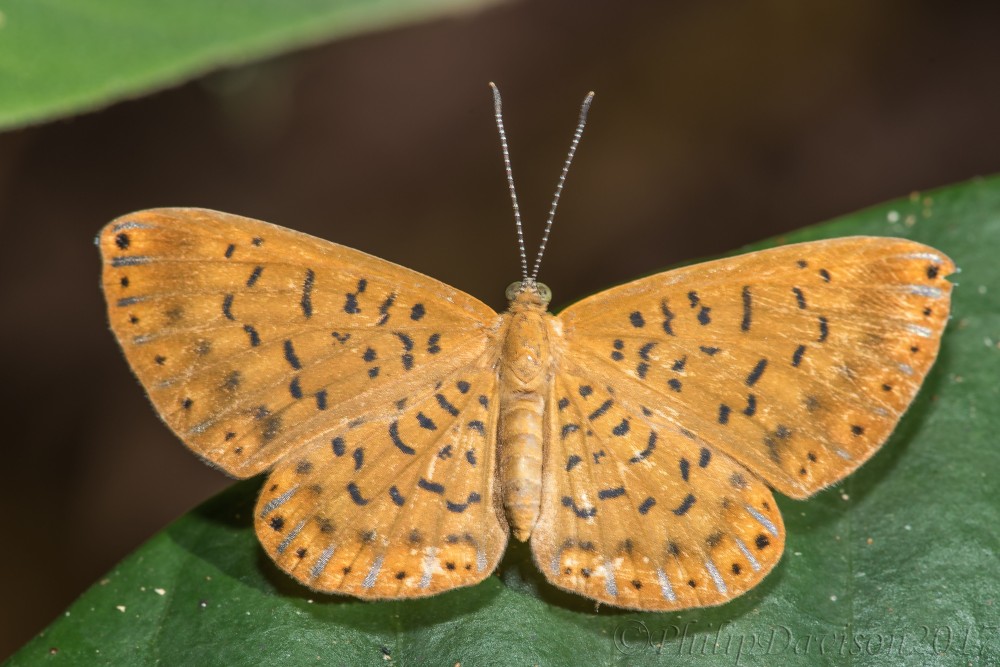
Metacharis victrix
At night the number of amphibians is starting to diminish. For some time now the number of species has reduced to 4 or 5 but the number of individuals of each species has dwindled to only one or two hopeful males calling for a mate. It is highly unlikely that there will be a response at this time of year. The Savage’s Thin-fingered Frogs, (Leptodactylus savagei), are increasing slightly in numbers around the pond. As the area continues to dry the pond is the only damp refuge and these large amphibians start to congregate around the pond edge sometimes entering the water where they can be found floating.
Floral Descent
Whereas many of the plants have been slow to flower, some of the orchids have not.. To see the orchids you generally need to up in the forest canopy, 88% of the Costa Rican orchids are epiphytic, they are up at the top of the trees. But occasionally you may be lucky to see some that have found a suitable location nearer to the ground. When not in bloom it is easy to miss them as many orchids have small insignificant flowers, but not all, others when in flower can have quite a showy display. Orchidaceae is a very species rich family of flowering plants rivalled only by the Asteraceae or daisy family in terms of numbers. Being so diverse makes them hard to identify. Many people admire them for their aesthetic, if sometimes subtle, beauty. They are therefore a group of greater interest to orchid specialists in terms of identification and geographical distribution. Equaled by the diversity of species and form of the flowers are the number of ways in which orchids become pollinated. Some of them have evolved means of attracting pollinators that would seem to be, on first reading, the stuff purely of science fiction.
Around the gardens and forests there are orchids that are slightly more obvious. Growing on some of the garden trees as epiphytes are the white-flowered, night-perfumed Lady of the Night, (Brassavola nodosa). At night the white flowers give off a heavy sweet perfume that attracts in hawkmoths. The moths hover in front of the flower and using the long proboscis probe for nectar. While doing so they become covered in pollen which is then transferred to the next flower they visit. Not too far away growing in the borders are the Bamboo Orchids, (Arundina graminifolia). This is a terrestrial orchid native to south east Asia. It is however widely grown in Costa Rican gardens. The purple bee pollinated blooms are born on long thin stems that resemble a bamboo stem.
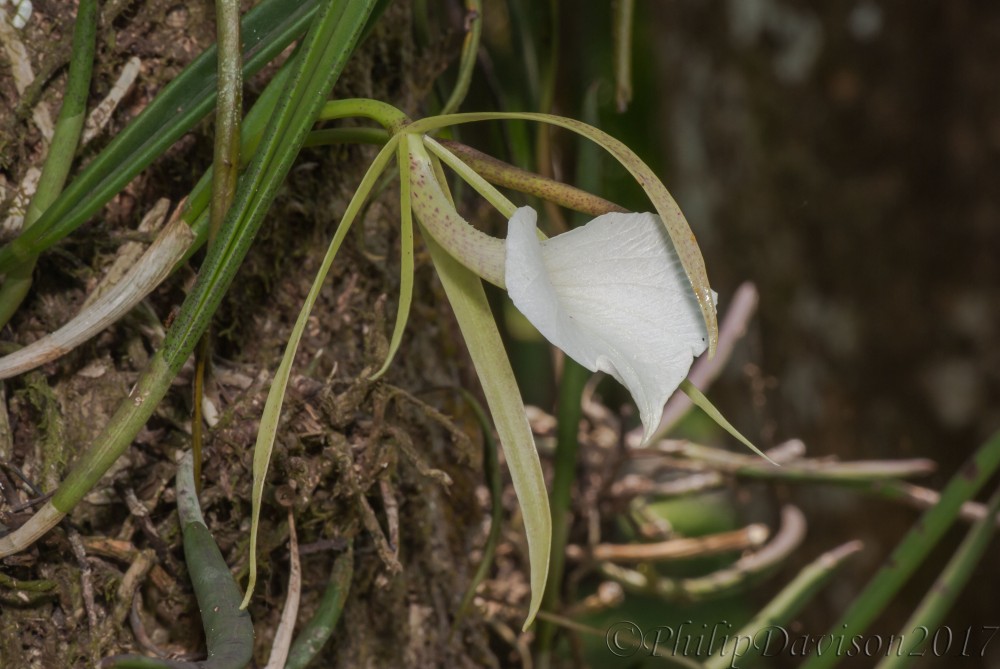
Lady of the Night, (Brassavola nodosa)
On the forest trails growing low down and in locations near to water you may find, (Stanhopea cirrhata). Stanhopea species emit an scent that attracts certain species of orchid bee. The males gather the scent which they mix with other plant volatiles to produce their own perfumes. The structure of the Stanhopea orchid is such that while the bee is gathering the scent a pollen package is attached to the bee which unwittingly transfers it to the next orchid it visits.
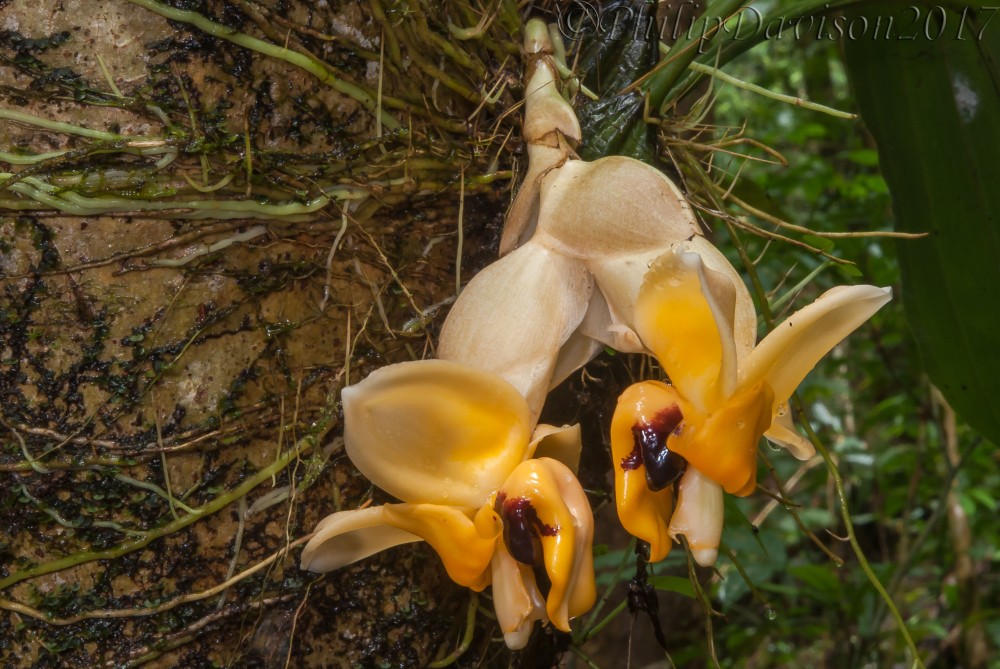
Stanhopea cirrhata
There are some orchids whose flowers are as green as their leaves. Numbering amongst them is the Vanilla Orchid, (Vanilla planifolia). In the wild Vanilla orchids are pollinated by orchid bees but when commercially grown and pollinated by hand. Growing on the sides of trees are some of the green flowered Epidendrum Orchids. There are about 160 species of Epidendrum in Costa Rica which makes them a little difficult to identify.
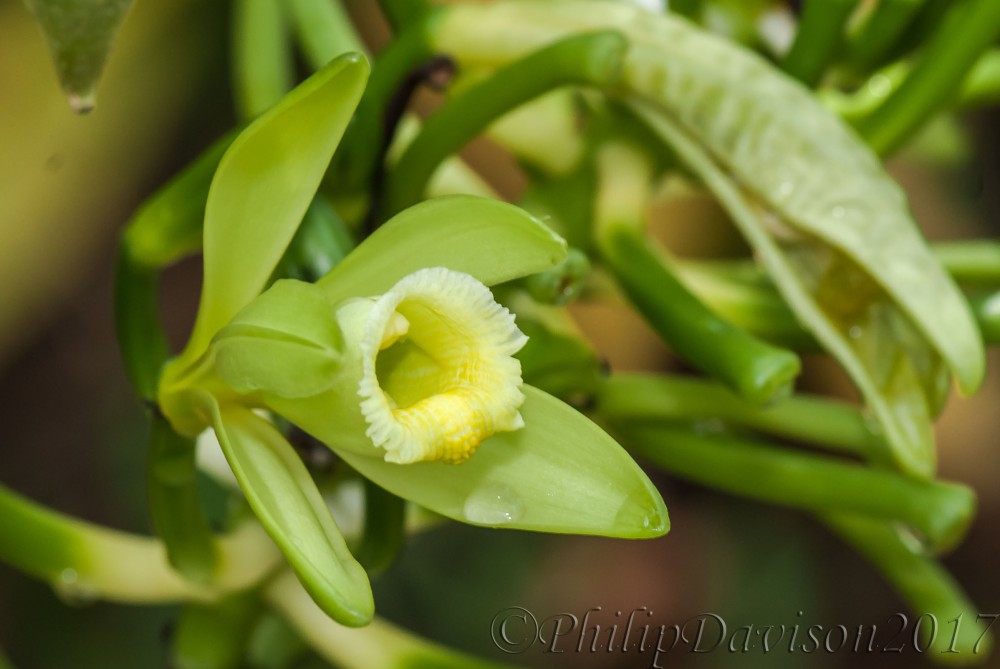
Vanilla Orchid, (Vanilla planifolia)
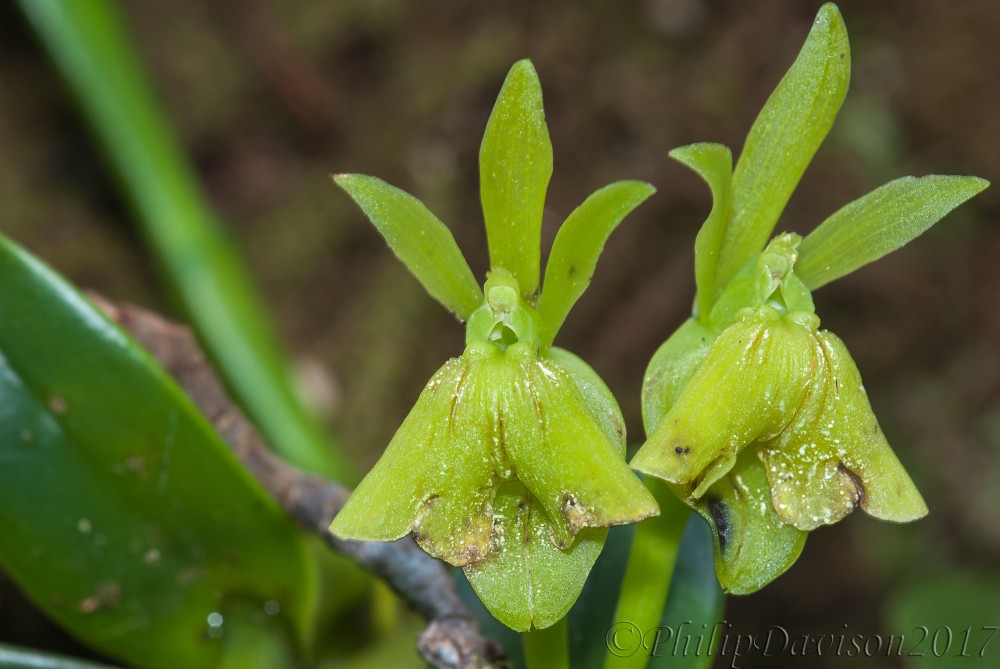
Epidendrum sp
Dragons and Damsels
If you spend enough time by any body of water around the grounds then you are likely to see some of the Odonates; dragonflies and damselflies. The dragonflies can more commonly be found still bodies of water such as the pond whereas the damselflies seem to frequent areas closer to running water such as the creek. They can also be seen in the gardens and throughout the forest too. You can tell a dragon from a damsel when they land as the dragonflies perch with the wings out to the sides whereas the damselflies perch with the wings folded together over the back.
You have to have patience to photograph dragon and damselflies. They react to the slightest movement near them by taking to the air. They do have favored perches though so if you set the camera up on a tripod or simply rest in a comfortable position, camera in hand, they well almost always return in short time and alight at the place from which they took off.
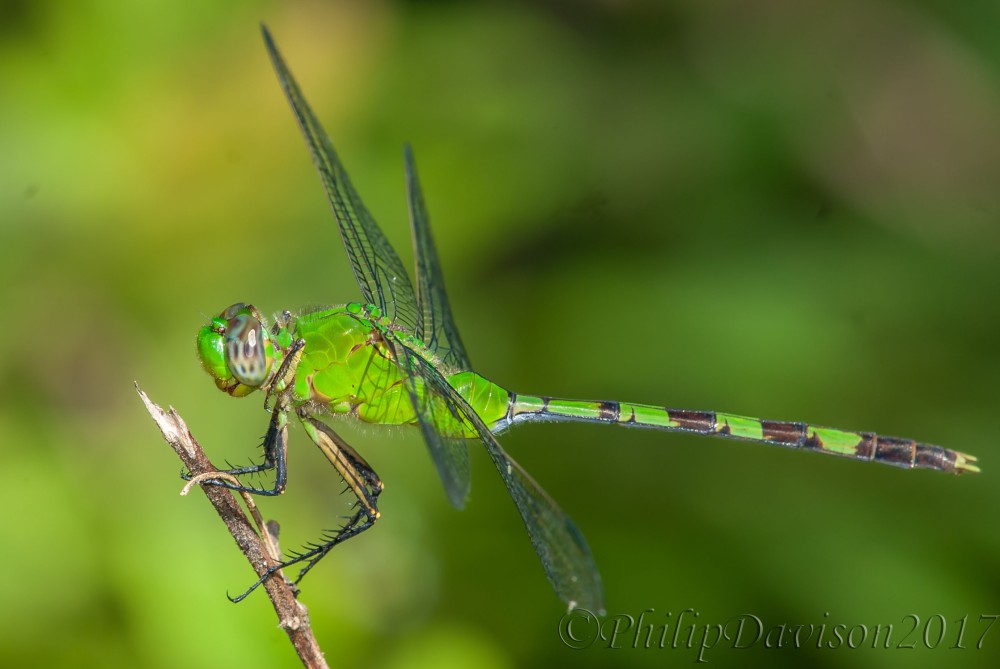
Great Pondhawk, (Erythemis vesiculosa)

Red-mantled Dragonlet, (Erythrodiplax fervida)
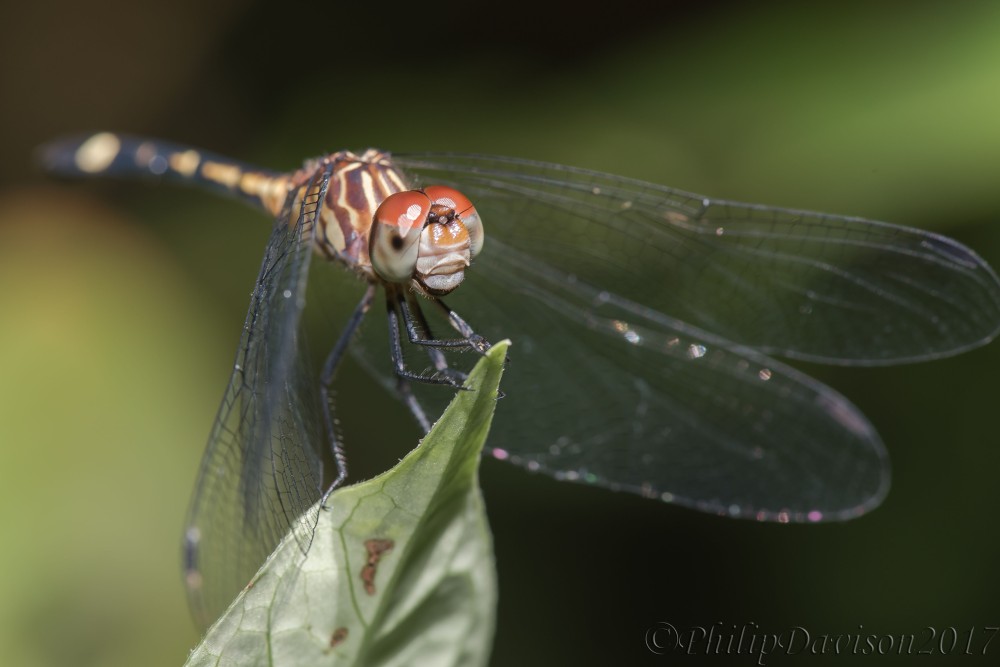
Three-striped Dasher, (Micrathyria didyma)
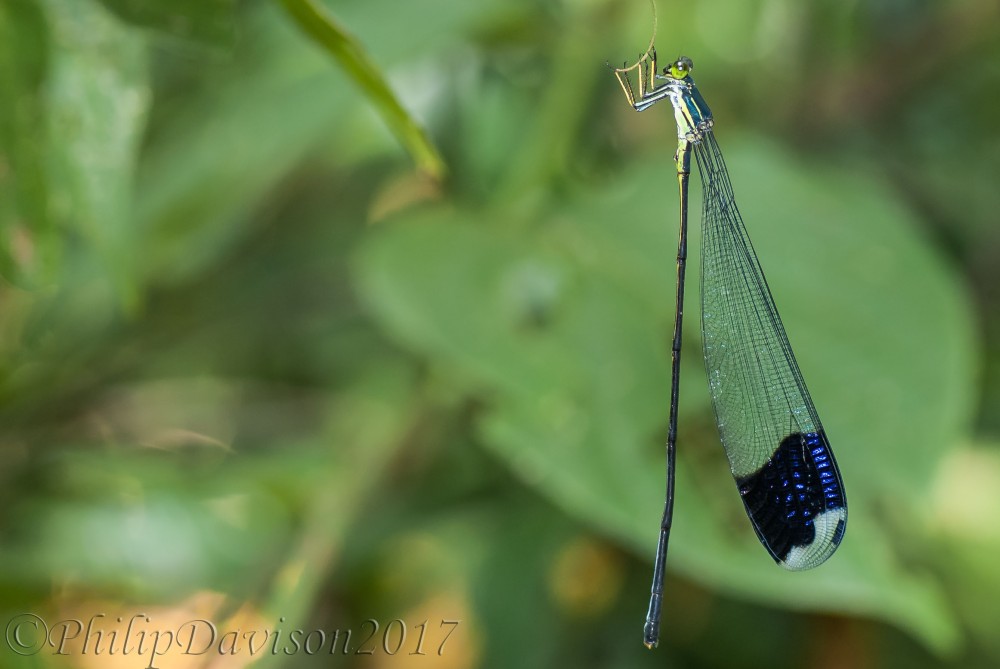
Helicopter Damselfly, (Megaloprepus caerulatus)
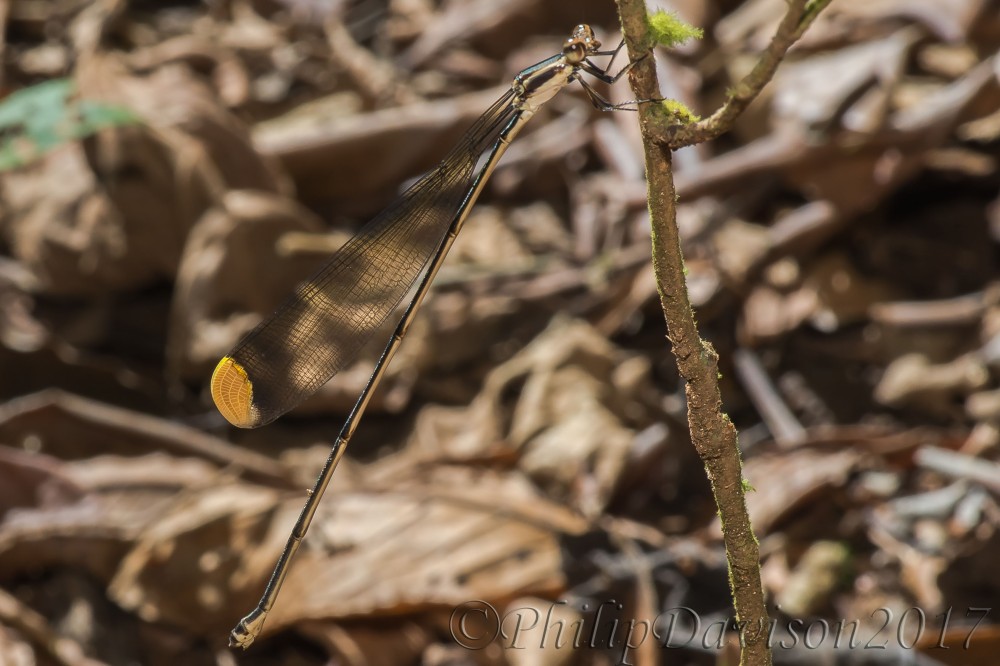
Ornate Helicopter Damselfly, (Mecisogaster ornata)
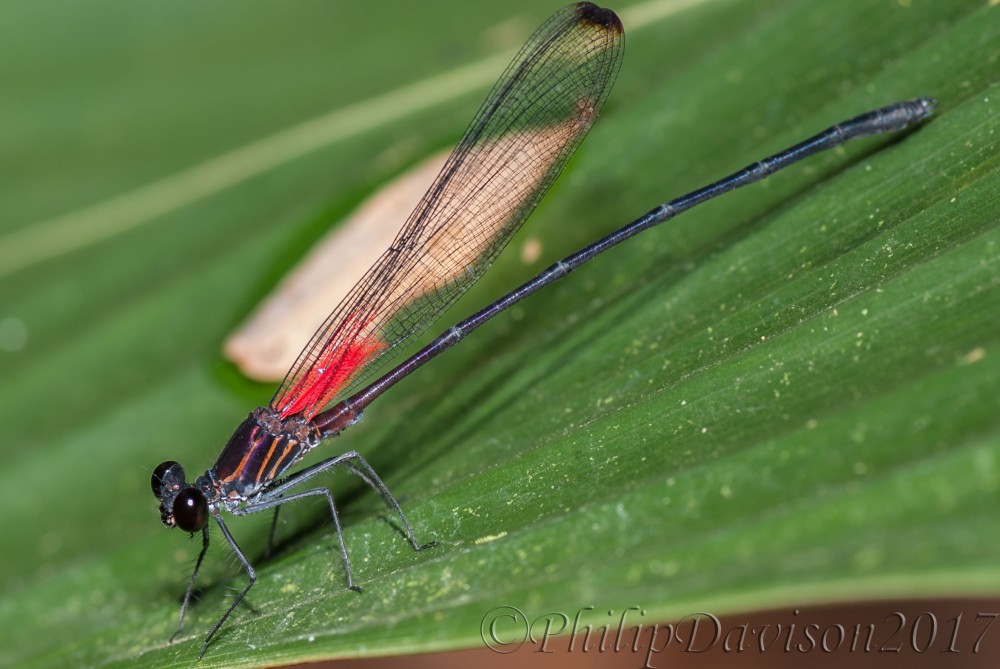
Hetaerina orissa
Philip Davison is a Biologist, Writer and Photographer Based in Costa Rica
Felipe del Bosque Blog June 19th 2011

More of the Same
The weather continues to stay settled with bright, dry days and a little rain at night. We are experiencing an occasional daytime shower but nothing like the torrential rains from the beginning of the rainy season. Hopefully things will continue in this fashion until September when we will be expecting heavier rain of longer duration.
For the moment, all unstable vegetation seems to have already fallen. That is not to say there will be no further tree falls over the coming months, but there have been no more large trees bite the dust, (that should be, wet forest floor), over the past week.
A team of experts were called in to cut up those unfortunate trees that were standing in the path of the giant Milky Tree that fell last week. Even though the Milky Tree itself had little value in terms of lumber, the others did. They were cut up in situ and the planking was then taken to be stored in the wood yard for future construction projects.
Counting By Numbers
People who study ants are known as myrmecologists and there are not too many of them. Most of the visitors to the forests that encompass Bosque del Cabo did not realize before they arrived that they would be leaving having become enamored by the fascinating world of ants. For those ant fans out there, at the moment, the ants are out in force. During the dry season it is not always easy to view the flowing green rivers of freshly cut leaf being carried by none other than the Leaf-cutter Ants. During the dry season they tend to work at transporting the leaf material back to the nest after the sun has set. But now, when there is a break in the rain, any of the trails at Bosque will provide you with ample opportunity to marvel at this incredible spectacle.
Another type of ant, whose presence can be equally as obvious, is the Army Ant. There are several different species of Army Ant in the area and to the untrained eye they may look to be one and the same. Whether they are larger or smaller, they have the same characteristic habit of moving in a congested column and always with purpose. Unlike the Leaf-cutter Ants which are mycovores, (fungus eaters), the Army Ants are strictly carnivores. Over the past week, I have been able to show people the feeder columns heading back to the bivouac, (they don’t have an established nest, they are nomads). With close scrutiny you can see a huge amount of dismembered arthropods being taken into the bivouac to feed the larvae. On occasion we will happen across a foraging front over 60 feet across, moving across the forest floor and dispatching anything small enough that did not have time to move out of the way.
The Comfort Zone
On the site of the “Killer Wasp” attack from a few weeks ago, we now have a new resident, something a little more tranquil by nature, a female Long-billed Hummingbird. She has chosen the underside of a leaf from a palm just to the side of the kitchen, behind the reception, to build her nest. The nest is still under construction. If you look closely you will see the strands of spider silk she has used to fix the nest to the leaf. Following the addition of each new piece, the female then sits inside to try it out, with the bill facing the underside of the leaf. She appears to be in a most uncomfortable looking position but it is how she will stay while incubating the eggs. Hopefully I will get more photographs as the nest is completed. There have been Long-billed Hummingbird nests in the same area, different leaves, in the past. Their proximity to a busy human though fare does not appear to deter them.

What Katydid
On one of the nightly “Sunset Tours” this week, I saw an unusual looking Katydid sitting on a leaf of the Calabash Trees. There is nothing unusual about seeing an unusual looking Katydid as many of them display strange morphological characteristics. There are a great many Katydids that have evolved to resemble various plant parts. The Pseudoleaf Katydids in particular are intriguing creatures. This one resembled nothing I had ever seen before. The wings were raised up above its back which brought to mind the prehistoric Dimetrodon. The color of the katydid was a mix of cryptic browns and grays that I can only imagine would blend in with the background color of the tree bark.




Philip is a biologist, writer and photographer as well as the onsite naturalist guide at Bosque del Cabo Rainforest lodge on the Osa Peninsula, Costa Rica.
www.bosquedelcabo.com
Photo Feature
Blooming Orchids and Stingless Bees
Over recent weeks, while taking guests out on tour through the primary forest, I noticed an orchid that had been growing on the side of a tree for many years had started to produce flower buds. This particular orchid had flowered every year and this year I kept a watch for bud development as I knew that the flowers would soon follow. Over the course of a few days the flower buds lengthened and then on this day as I walked past, there were the flowers. So after lunch it was back on the same trail with camera to get the images.

The orchid is a Tendril Stanhopea, (Stanhopea cirrhata). It is a Neotropical orchid of which there are 55 species, 3 occurring in Costa Rica, but only one on the Osa Peninsula. Stanhopea orchids are normally found in cooler climes, but Stanhopea cirrhata prefers growing exactly where this one is; in tropical lowland wet forest, low down on a branch in a less sunny location and close to the creek. The flowers occur as a pair and give off a very sweet fragrance which not surprisingly attracts in male Orchid Bees, which are the plants main pollinators. When I arrived to take the photograph, there was an Orchid Bee hovering in front but it did not wait for me to capture its image for later identification.

There had been some other bees that I had taken a mental note to return and photograph on the same trail as the orchids. A few weeks previous I saw a swarm of brilliant orange/yellow bees gathering on plant leaves, close to the ground, at the base of a Milky Tree. Following their appearance, over the course a week or so, a long waxy tube started to form from a crevice in the tree. The tube was reddy orange in color, and extended 6 inches or more horizontally from the tree trunk. These were one of the species of Stingless Bees, (Tetragonisca angustula). The color of the tube depends upon the type of flowers that the bees have visited. Incorporated into the wax you may also find mud and plant fibres.
They may be stingless but they can certainly bite and hard too. They are renowned for their tenacity, swarming on mass into the mouths, ears and nose of those who antagonized them. Some species as they bite release caustic secretions which burn.

Before the introduction of the European Honey Bee, Stingless Bees were the main source of honey for the indigenous peoples of Costa Rica and many of them still prefer Stingless Bee honey. The honey itself has been clinically proved to have an antibiotic property. You have to be careful which bees you are using though as some of them make a honey poisonous to humans.
Text and Photographs are taken from the forthcoming book:
The Natural History of Bosque del Cabo by Philip Davison
Temperature and Rainfall
Average Daily Temp High 83°F. Average Daily Temp Low 74°F.
Average Daily Rainfall 0.33 ins. Total Weekly Rainfall 2.28 ins
Average Daily Temp High 27.9°C. Average Daily Temp Low 23.1°C.
Average Daily Rainfall 8.3 mm. Total Weekly Rainfall 57.9 mm
Species List for the Week
Mammals
- Howler Monkey
- Spider Monkey
- Capuchin Monkey
- Red-tailed Squirrel
- Agouti
Birds
- Orange-chinned Parakeets
- Red-lored Amazon
- Scarlet Macaw
- Great Currasow
- Crested Caracara
- Mangrove Black Hawk
- Roadside Hawk
- Yellow-headed Caracara
- Common Paureque
- Lineated Woodpecker
- Black-hooded Antshrike
- Chestnut-backed Antbird
- Wedge-billed Woodcreeper
- Short-billed Pigeon
- White-tipped Dove
- Rufus Piha
- Rufus-tailed Hummingbird
- Red-capped Manakin
- Chestnut-mandibled Toucan
- Great Tinamou
- Little Tinamou
- Bright-rumped Atilla
- Masked Tityra
- Black-throated Trogon
- House Wren
- Black Vulture
- Turkey Vulture
Reptiles
- Barred Ameiva
- Four-lined Ameiva
- Golfo Dulce Anolis
- Pug-nosed Anole
- Clawless Gecko
- Mediterranean House Gecko
- Cat-eyed Snake
- Litter Snake
- Salmon-bellied Racer
Amphibians
- Marine Toad
- Red-eyed Green Tree Frog
- Banana Frog
- Masked Smilisca
- Milky Frog
- Small-headed Frog
- Smokey Jungle Frog
- Black and Green Poison Arrow Frog
- Golfo Dulce Poison Arrow Frog
- Fitzinger’s Rain Frog
- Tink Frog
Butterflies
- Adelpha cytherea
- Caligo eurilochus
- Chioides albofasciata
- Colobura dirce
- Corticea corticea
- Cupido comyntas
- Detritivora gynaea
- Dryas iulia
- Euphyes vestries
- Eurybia lycisca
- Heliconius cydno
- Heliconius erato
- Heliconius hecale
- Heliconius ismenius
- Heliconius sapho
- Heraclides cresphontes
- Hermeuptychia hermes
- Junonia everete
- Morpho helenor
- Morpho menelaus
- Pareuptychia ocirrhoe
- Parides erithalion
- Pierlla helvina
- Pierella luna
- Pseudolycaena damo
- Pyrgus oileus
- Pyrisitia nise
- Siproeta stelenes
- Urbanus simplicius
Plants
- Astrocaryum Palm Fruiting
- Black Alligator Tree Flowering and Fruiting
- Calabash flowering and fruiting
- Cedrillo Fruiting
- Clusia Vine Fruiting
- Devil’s Little Hat Fruiting
- Dinner on a Plate Fruiting
- Monkey Comb Tree Flowering and Fruiting
- Candlestick Plant Flowering and Flowering.
- Cannonball Tree Flowering
- Figs Fruiting
- Inga Fruiting
- May Tree Fruiting
- Manglillo Fruiting
- Nutmeg Fruiting
- Royal Palm Fruiting
- Santa Maria Flowering and Fruiting
- Stanhopea Orchid Flowering
- Stinky Toe Fruiting
- Ylang ylang Flowering
8.565093
-83.511169






















